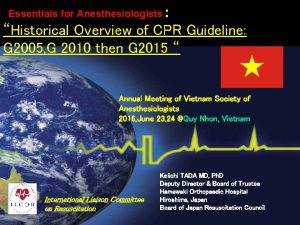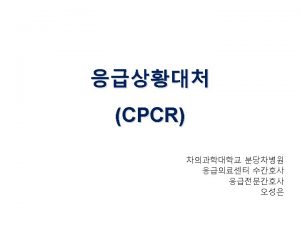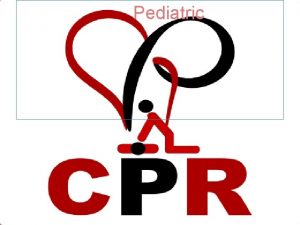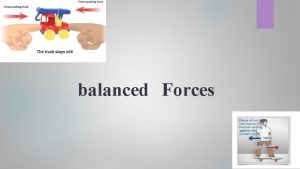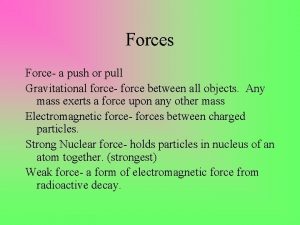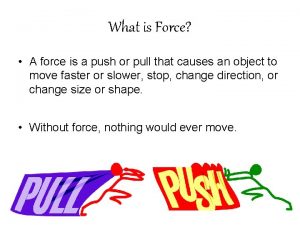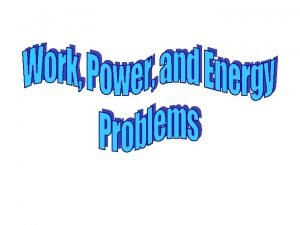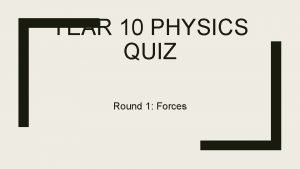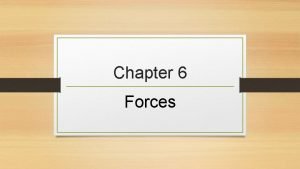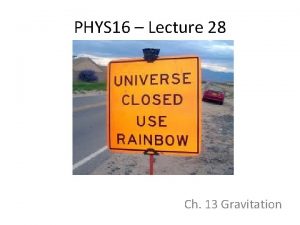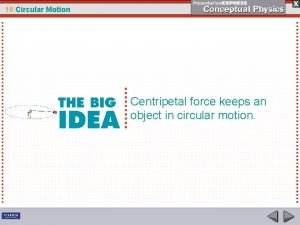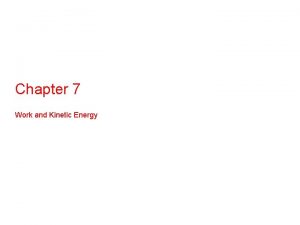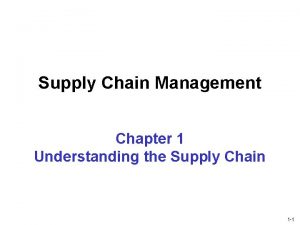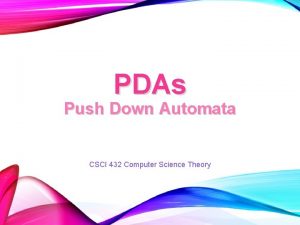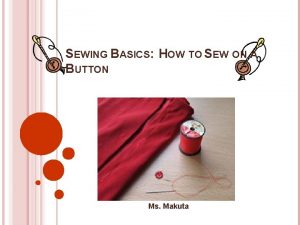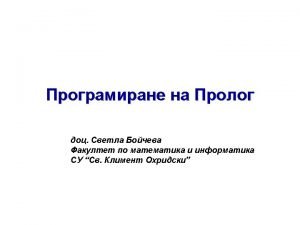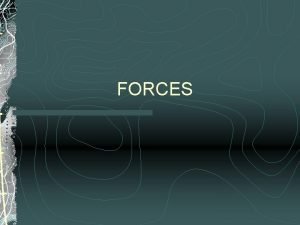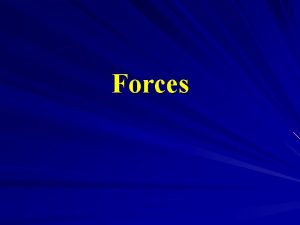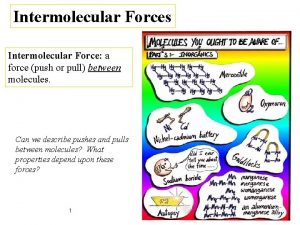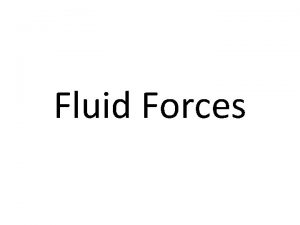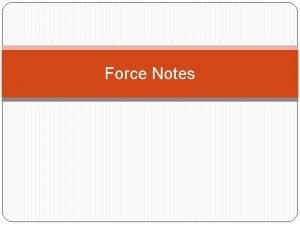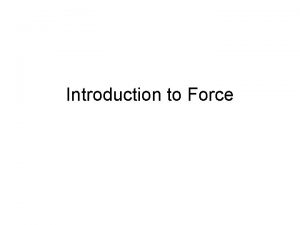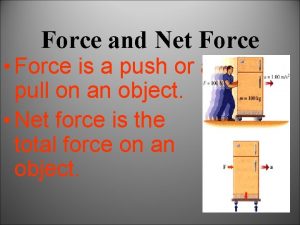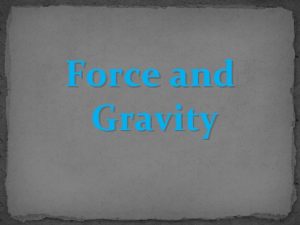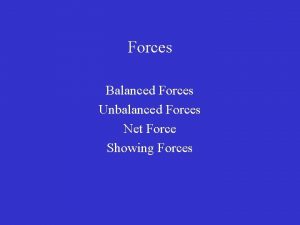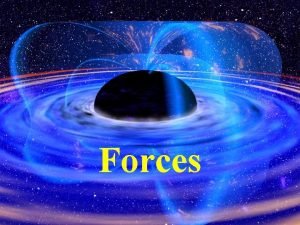What are Forces Force a push or a










































- Slides: 42

What are Forces?

Force

• a push or a pull • a force gives energy to an object causing it to… – start moving, stop moving, or change direction • the unit of measurement is Newtons (N) – used to be a kg(m/s 2) – this is about ¼ pound • forces in the same direction are added to make the resulting force stronger • forces in different directions are subtracted which makes the resulting force weaker – if these forces are equal, they are balanced forces


Types of Forces • Contact Forces: the objects involved are touching each other and friction is created – friction is a force opposes motion – 3 types of friction • rolling • sliding • fluid – this is caused by an object moving through a liquid or a gas

• Non-contact forces: objects are pushed or pulled without being touched – gravity – electricity – magnetism

Force formula F = ma or F = m·a or F = m x a or F = m(a) F = Force m = mass a = acceleration

Two ways an object has force and how to use the force formula 1. Object is accelerating. – if it is rolling, flying, and/or sliding it has a force – think of a car hitting you 2. Object is NOT moving (more on this later) – this is a result of gravity – think of a car on top of you!

Example problem • A rocket has a mass of 3. 5 kg and an acceleration of 3. 0 m/s 2. What is the rocket’s force? given formula set up problem answer w/ unit of measurement m=3. 5 kg F=ma 3. 5 kg(3. 0 m/s 2) a=3. 0 m/s 2 10. 5 kg(m/s 2) A kg(m/s 2) is the same as a Newton so 10. 5 N would be the same, but simpler.

Newton’s Laws of Motion Sir Isaac Newton Scientist and Mathematician 1642 - 1727 If I have been able to see further, it was only because I stood on the shoulders of giants.

First Law of Motion • This is also known as the Law of Inertia – objects in motion will remain in motion unless acted upon by an unbalanced force – objects at rest will remain at rest unless acted upon by an unbalanced force – or put another way-- objects "tend to keep on doing what they're doing. "





Second Law of Motion • explains how force, mass, and acceleration are related – if you place a force on an object, it will accelerate in the direction you push/pull it – this acceleration is directly proportional to the force • this means if you push it twice as hard, it will accelerate twice as fast – this acceleration is inversely proportional to the mass of the object • this means if you use the same force to push a object with twice the mass of a smaller object it will accelerate half as fast

Newton’s Second Law of Motion • Force = mass X acceleration • F = ma • Force and acceleration are directly proportional. The greater the force, the greater the acceleration. • Mass and acceleration are inversely related. The greater the mass of an object the less the acceleration if the same force is applied.


• F=ma – If you know 2 out of the 3 (F, m, or a)-- then you can calculate the rest. • m = F/a • a = F/m • How much force is needed to accelerate a 80 kilogram bike and its rider 6 m/s/s? given formula set up problem answer w/ unit of measurement m= 80 kg F=ma a= 6 m/s/s 80 kg (6 m/s/s) kg(m/s 2) = Newton 480 N

Third Law of Motion • for every action, there is an equal and opposite reaction • all forces come in pairs • in order to move, you must “push off” from something.



What is friction? • Friction is a force which opposes motion. • Friction is an important force in our lives. We rely on friction in many ways. An athlete usually wears shoes which provide him or her with a greater friction between the shoe and the surface. We rely on friction as an important aspect of our motion. In what other ways does friction play a role in our everyday lives?

From Glencoe Physical Science

What causes friction? • There are two factors which affect friction between two surfaces: – Kind of surfaces in contact (rough or smooth) – Amount of force pressing the surfaces together. The rougher the surface and the stronger the force between the surfaces, the greater the amount of friction.

What is static friction? • If you were trying to move a box like pictured below and the box did not move, this would be static friction. • Static friction is friction between two surfaces which are not moving past each other. From Glencoe Physical Science

What is sliding friction? • Sliding friction occurs when a force is great enough to overcome the static friction. What is rolling friction? Glencoe Physical Science • Rolling friction is the friction which enables wheels to turn and objects to move. If there were no friction, turning wheels would not enable an object to move.

Air Resistance – another type of friction? ? • Air resistance is a force which opposes a moving object. This can be easily seen with falling objects. When a piece of paper and a crumple piece of the same type of paper are dropped, they fall at the same rate. • A penny and a feather dropped in air will not fall at the same rate, but a penny and feather dropped in a vacuum (no air) will.

What is terminal velocity? • Forces cause objects to accelerate (2 nd Law). • When the force of gravity on a falling object equals the force of the air resistance going against gravity, the forces balance out and the object stops accelerating. • The object will travel at a constant velocity – the terminal velocity.

What is Gravity? • Gravity is a force of attraction between two objects. • Law of Gravitation – any two masses exert an attractive force on each other. The amount of attraction depends upon two things: the mass of the objects and the distance between the objects.

What is gravitational acceleration? • When objects fall they accelerate toward the ground. • Using Newton’s 2 nd Law we can see this relationship: F = ma • The force caused by gravity acts upon a certain mass to cause it to accelerate toward the ground at a constant rate. • Acceleration due to gravity is 9. 8 m/s 2

Gravity causes weight • The weight of an object is caused by the force of attraction between the earth and objects on the surface of the earth. Gravitation force is equal to weight, therefore…

How much does a person with a mass of 70. 0 kg weigh on the earth? Weight = mass X 9. 8 m/s 2 Weight = 70. 0 kg X 9. 8 m/s 2 Weight = 686 N Remember that 1 N = (1 kg) (1 m/s 2)

What is weight? • When an astronaut moves away from the earth they “lose” weight. Weight is caused by the force of attraction between the earth and objects on its surface. The greater the distance an object has from the earth, the less the force of attraction which would exist.

What is the difference between mass and weight? • Mass is the amount of matter in an object. This does not change in an object as it moves away from the earth. • Weight is caused by gravity. Therefore, the greater the distance, the less the force of attraction. The less the distance the greater the force of attraction. • Your weight is dependent upon the mass of the earth. If you were able to go to the planet, Jupiter, your weight would be 27 time greater, because the mass of Jupiter is 27 times greater.

What causes “weightlessness”? • Even in the space shuttle, there is a force of attraction exerted by the earth on the shuttle and its contents. • When the space shuttle temporarily “falls” toward the earth, the contents of the space shuttle appear to be weightless, but in fact they are falling with the space shuttle. This is called “freefall”.

What is projectile motion?

When an object is thrown into the air, two forces and two motions affect the movement of the object. The object may be thrown horizontally with a certain force, but the vertical force of gravity combines to affect the motion. Slow projectile - shoot a monkey Fast projectile - shoot a monkey

What is centripetal force? • “centripetal” means to move toward the center. • Centripetal acceleration is the acceleration of an object toward the center of a curve or circular path. • Centripetal force is a force toward the center of a circle which holds the moving object in its circular path.


What is momentum? • The momentum of an object is equal to the product of its mass and its velocity. The unit for momentum is kg m/s

What is the Law of Conservation of Momentum? • When object collide the momentum of one object is transferred to the other object. • Pool balls give a wonderful example of this during a pool game
 Antigentest åre
Antigentest åre Push hard push fast fully recoil
Push hard push fast fully recoil Asp medical
Asp medical Push hard push fast fully recoil
Push hard push fast fully recoil Resuscitation triangle roles
Resuscitation triangle roles Push hard push fast fully recoil
Push hard push fast fully recoil Push hard push fast fully recoil
Push hard push fast fully recoil What is meant by the term balanced forces
What is meant by the term balanced forces Is gravitational force a push or pull
Is gravitational force a push or pull Market pull technology push
Market pull technology push Technology push vs market pull
Technology push vs market pull Multiple valve springs are used primarily to
Multiple valve springs are used primarily to Gravity force
Gravity force Amy uses 20n of force to push a lawn mower 10 meters
Amy uses 20n of force to push a lawn mower 10 meters Intra vs intermolecular
Intra vs intermolecular Constructive and destructive forces
Constructive and destructive forces Intermolecular force of attraction
Intermolecular force of attraction The forces shown above are pushing/pulling forces
The forces shown above are pushing/pulling forces Resultant of like and unlike parallel forces
Resultant of like and unlike parallel forces Contact and noncontact forces
Contact and noncontact forces Intramolecular vs intermolecular bonds
Intramolecular vs intermolecular bonds Force examples in everyday life
Force examples in everyday life Vector free body diagram
Vector free body diagram Which of the following forces is a contact force? *
Which of the following forces is a contact force? * Whats a noncontact force
Whats a noncontact force Advantage
Advantage Normal force and shear force
Normal force and shear force What force provides centripetal force
What force provides centripetal force Why electric force is conservative
Why electric force is conservative What is net force
What is net force Contact vs long range force
Contact vs long range force Centripetal force and gravitational force
Centripetal force and gravitational force Centrifugal force definition geography
Centrifugal force definition geography What force provides centripetal force
What force provides centripetal force Hooke's law vector form
Hooke's law vector form Is tension contact or noncontact
Is tension contact or noncontact Supply chain cycle
Supply chain cycle Pull-push takeoff
Pull-push takeoff Promocin
Promocin Pda computer science
Pda computer science Push back bob sew in
Push back bob sew in From pyfcm import fcmnotification
From pyfcm import fcmnotification Push dose epi
Push dose epi



